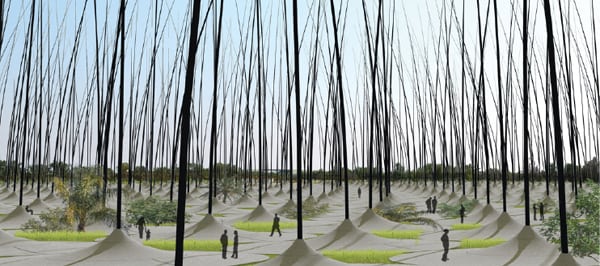The Art of Power Generation
Much opposition to large-scale renewable projects concerns aesthetics. U.S. federal regulators, for example, ordered the developer of the $1 billion Cape Wind project—a 468-MW offshore wind farm proposed to be built in a 25-square-mile section of Nantucket Sound off the Massachusetts coast—to change the design and configuration of the project to reduce “visual impacts.” Among required changes, certain to slash profit margins, are cutting the number of turbines from 170 to 130 and reconfiguring the array to move it farther away from Nantucket Island.
But what if giant installations such as wind farms or solar arrays could be designed as mammoth sculptures, delivering compelling aesthetic as well as economic value? That’s the challenge put to artists, scientists, architects, and engineers around the world by the Land Art Generator Initiative (LAGI), which began in January. The theme of the international competition, which closed this past June, was grid-connected renewable power. The submission criteria were simple: Proposed projects must produce no negative environmental impacts and must be accompanied by an environmental impact assessment. There are no limits on the type of energy generation employed, so long as it is tested. The grand prize: Construction on three potential tracts of land in Abu Dhabi.
According to LAGI, land art is an art movement in which landscape and work of art are inextricably linked. “Works of Land Art are sometimes created with only the natural materials of the surroundings,” it says on its website. “In this case, we are asking interdisciplinary artist teams to use technology as the medium for art in a way that is sympathetic to and inspired by the natural surroundings.”
Though the initiative admits that it has yet to attract investors, public or private, to build the winning project, it says it received more than 300 entries for the competition. And it has already chosen a winner, which will be made public at an award ceremony at the 2011 World Future Energy Summit in Abu Dhabi between Jan. 17 and 19, 2011. Some 50 otherwise-unbelievable shortlisted designs are showcased on the organization’s website (http://www.landartgenerator.org/blagi/).
Second-place mention, for example, mimics “the way the wind caresses a field of wheat, or reeds in a marsh; our hair on a gusty afternoon.” The project by design firm Atelier dna consists of 1,203 carbon fiber “stalks,” 55 meters (m) high and tipped with LEDs. The stalks are anchored to the ground by concrete bases ranging from 10 m to 20 m in diameter (Figure 4). Within each pole is a stack of piezoelectric ceramic discs and electrodes. When the wind sways the poles—“chaotically,” as envisioned by the developers—the stack of disks is forced into compression, thus generating a current through the electrodes. The current is routed to a torque generator inside the concrete base that converts the kinetic energy into electricity.
 |
| 4. Windstalks. An international competition that challenged artists and engineers around the world to create grid-connected large-scale renewable energy sculptures drew more than 300 entries before it closed in June. The competition was sponsored by the Land Art Generator Initiative and Abu Dhabi firm Masdar. Second place was awarded to “Windstalks,” a project that would erect about 1,200 “stalks,” 55 meters high, which are anchored to the ground with concrete bases. The stalks house piezoelectric ceramic discs and electrodes, which generate current when swayed by the wind. The design includes an innovative energy storage system. Courtesy: Atelier dna |
“The electricity that our project generates isn’t constant, it depends on the wind,” the developers of “Windstalks” say. “To compensate we make a kind of battery, a capacitor, a way to store energy: Below the field of poles are two very large chambers, chambers as large as the whole site…. There’s [an] upper chamber and a lower one beneath. When the wind blows, part of the electricity generated powers a set of pumps, the pumps move water from the lower chamber to the upper one. When the air is still—when there is no wind—the water from the upper chamber flows down again turning the pumps into generators.”
Other impressive designs included the so-called “Solaris,” a project that garnered third place for proposing an “abstract art space that allows for escape and contemplation” as an “antidote” to the “frenetic future-scape internationalism” of the rapidly developing Arabian coast. That project, by Predock Frane Architects, features a spatial enclosure draped with a flexible solar module canopy—“like the woven hair of a Bedouin ‘black tent,’” as the firm describes it. The solar modules, created by technology company Cool Earth, are essentially Mylar balloons that concentrate the sun’s rays onto cells of highly efficient photovoltaic material. One concentrated cell produces nearly 400 times the energy of a conventional cell, and with close to 25,000 solar cells on the canopy, the project could produce an average of 73,000 MWh per year, the developers claim.
—Sonal Patel is POWER’s senior writer.